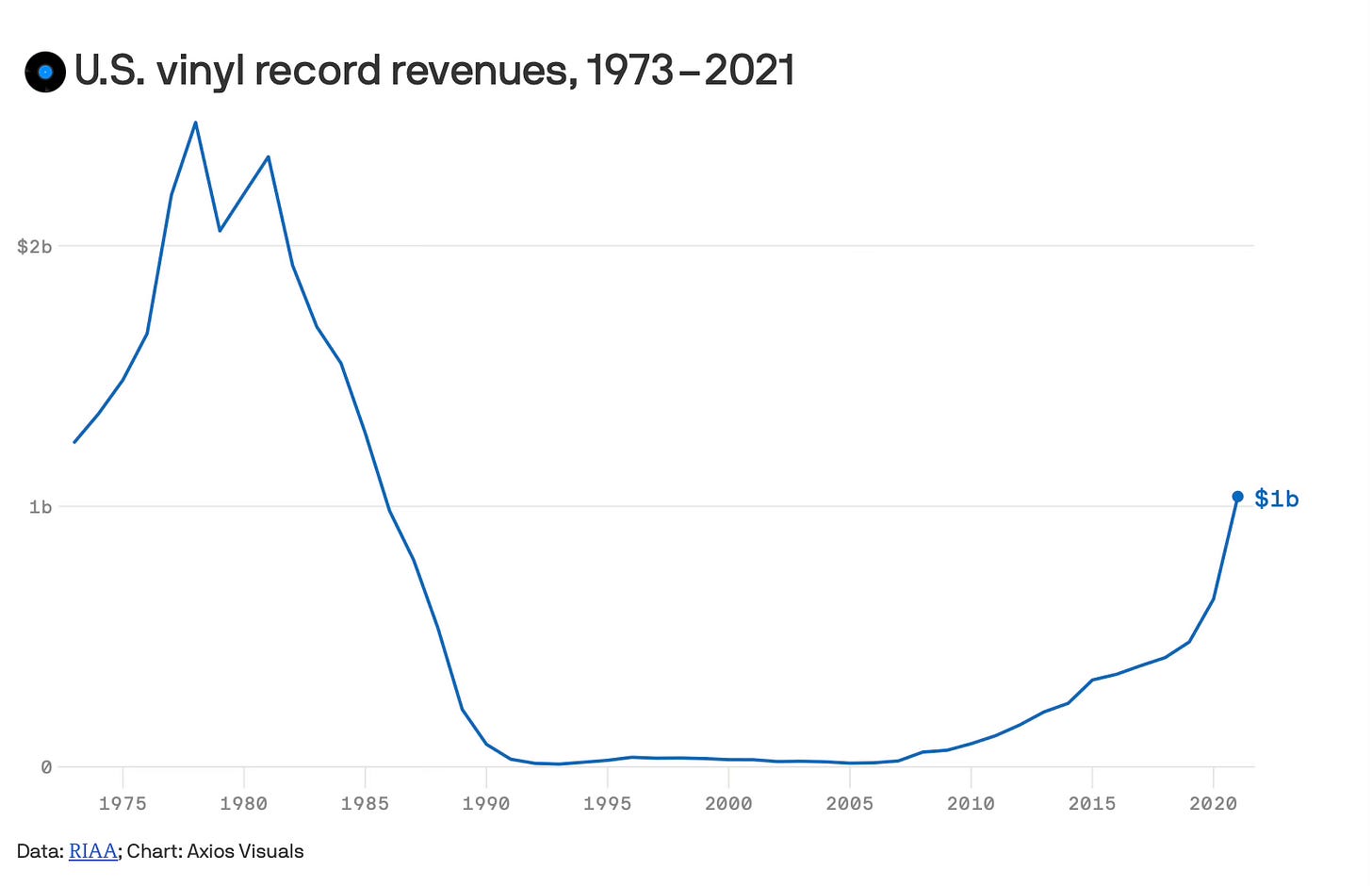Trend Life-Cycle: Why We Need to Better Understand How Trends Develop
The case of the revival of vinyl records
Sales of vinyl records are hitting record marks, year after year. Really? How can that be? After all, weren’t we all expecting that the rise of the mp3 — and later streaming services — would finally end the story of the vinyl record? Once the CD was declared dead, vinyl was supposed to remain a small niche for audiophiles and collectors. Yet here we are: the supposedly obsolete medium has outpaced digital downloads.
To test this, I looked up the latest figures — and they’re remarkable.
In 2024, vinyl album sales in the UK grew by 10.5 %, generating around £196 million in revenue, compared with just £126 million from CDs. Total vinyl sales reached about 6.7 million LPs, the highest since the early 1990s. The pattern isn’t isolated: in the U.S., vinyl revenues rose 10 % in 2023 to $1.4 billion, accounting for over 70 % of all physical music revenues — and outselling CDs for the second consecutive year. Globally, the vinyl record market is now worth nearly $2 billion and projected to grow to $3.5 billion by 2033.
Clearly, this is no nostalgic blip. It’s a full-fledged phase in the ongoing life-cycle of a trend.
From Trend Forecasting to Trend Understanding
I argued years ago that we need a deeper understanding of the life-cycle of trends — not only to grasp where they come from, but also to assess how and why they diffuse. Drawing on the work of Ryan Mathews and Watts Wacker (The Deviant’s Advantage), I emphasized that trends rarely move from fringe to mainstream in a straight, predictable line.
Trends live, die, and — as vinyl shows — can be reborn.
This “afterlife” of trends is just as important as their initial rise. The idea that a trend’s relevance ends once it hits the mass market misses the point. Cultural, social, and emotional factors can reignite old trends in new contexts — sometimes multiple times over.
The Case of Vinyl: A Trend Revival Story
So what explains vinyl’s resurgence?
Rather than asking how much further this trend might grow, it’s more insightful to ask what enabled this revival in the first place. A few possible forces come to mind:
Cultural nostalgia – a yearning for tactile, analog experiences in an increasingly digital world.
Aesthetic and authenticity value – the ritual of playing a record, the artwork, the imperfections — all part of a sensory experience streaming can’t replicate.
Identity and community – owning vinyl signals discernment and belonging to a subculture that values intentional listening.
Market reconfiguration – independent artists and small labels rediscovered vinyl as a storytelling and branding medium.
Importantly, vinyl’s comeback has been slow and cumulative rather than sudden: in the U.S., annual vinyl album sales rose from 13 million units in 2016 to nearly 50 million in 2023 — a 300 % increase. In Europe, production of vinyl records grew by 50 % in just the first half of 2025. This pattern shows that once a cultural form re-enters circulation, it can build sustainable momentum over time.
Looking Beyond the Short Term
The vinyl story highlights a broader issue: our collective bias toward short-termism.
In business, culture, and technology, we tend to be obsess over the next big thing — the next platform, the next hype cycle — and overlook the slow-moving, cyclical nature of cultural trends.
Understanding trend life-cycles means recognizing that decline is not the end. Trends can hibernate, transform, and return in new guises. They may lose commercial mass but gain cultural depth.
And that’s perhaps the key takeaway:
If we want to make sense of the future, we must understand not only what’s emerging, but also what’s re-emerging — and why.
A Closing Thought
Vinyl’s revival is more than a quirky anomaly in the music industry. It’s a reminder that trends are living systems — shaped by human desires, cultural meanings, and social feedback loops.
And as long as we remain human, the past will always find new ways to remix itself into the future.



Hi Jan Olivier and thank you for a good post. I agree with you and the post resonates with some thoughts I've had regarding the "S-curve" - to often I think forecasters and foresighters bring up this dynamic without deliberation. Trend maturation - at what level? And with what characteristics. Not to mention the afterlife aspect.